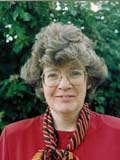 Mary Jenkins is a collector of Welsh
textiles and taught in adult education in Wales. Her family roots are in
Pembrokeshire in South West Wales, a county that produced some of the finest old
Welsh quilts and is caretaker of a family quilt made there in the 19th century.
She wrote HOUSE AND GARDEN SAMPLES and co-authored
MAKING WELSH QUILTS both
published by Krause Publications. She is a member the Quilters Guild of the
British Isles and as a Regional Coordinator advised on the formation of many
quilting groups within Wales. Mary Jenkins is a collector of Welsh
textiles and taught in adult education in Wales. Her family roots are in
Pembrokeshire in South West Wales, a county that produced some of the finest old
Welsh quilts and is caretaker of a family quilt made there in the 19th century.
She wrote HOUSE AND GARDEN SAMPLES and co-authored
MAKING WELSH QUILTS both
published by Krause Publications. She is a member the Quilters Guild of the
British Isles and as a Regional Coordinator advised on the formation of many
quilting groups within Wales.
I had been part of the patchwork
and quilting revival in Britain in the late 1970s, when we were excited by
American quilts with their wonderfully romantic names and infinite variety of
patterns. No one I knew then in the quilting world in Wales was greatly
interested in old Welsh quilts, I returned to quilting after a ten-year gap
spent teaching and designing embroidery, though like a true fabric-holic I never
stopped collecting fabric. Probably the break gave me a new perspective
because I looked afresh at Welsh quilts and fell in love with them.
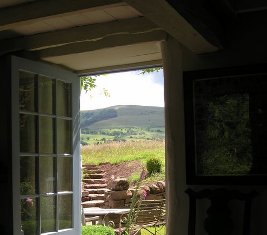
So what actually are Welsh Quilts and what makes them special? I would say that
a ŌĆśWelsh QuiltŌĆÖ is one that has been made in the style associated with Wales for
at least 200 years. This style can be identified by the quilting layout and the
traditional motifs used in the patterning. All other quilts are quilts that
happen to be made in Wales but could have been made anywhere as they have no
distinctive quilting patterns and associated motifs and only their provenance
links them with their home country.
In the 19th century it was possible for quilts to be one hundred per cent Welsh
because we had
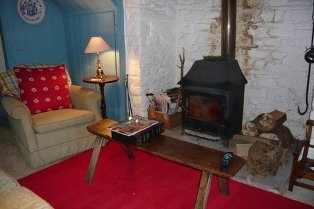 a wool fabric industry. In a country famous for sheep, the wool
was not only used to make fabric but also used as a filling for the quilts, so
Welsh quilts could be described as entirely home made. a wool fabric industry. In a country famous for sheep, the wool
was not only used to make fabric but also used as a filling for the quilts, so
Welsh quilts could be described as entirely home made.
The materials used were further enhanced by the method of quilting; the
combination of traditional patterning and the springiness of a wool filling gave
our quilts their very distinctive sculptured appearance and stamped them with
their Welsh identity. Not all Welsh
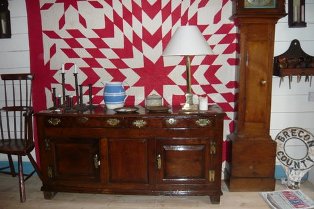 quilts were made of wool, however. When
roller-printed fabric produced in the cotton mills of Lancashire became
generally available, Welsh quilters used the new fabric, but they also continued
to use the quilting layouts and motifs that gave their quilts a Welsh identity. quilts were made of wool, however. When
roller-printed fabric produced in the cotton mills of Lancashire became
generally available, Welsh quilters used the new fabric, but they also continued
to use the quilting layouts and motifs that gave their quilts a Welsh identity.
When I finally decided to try to make a Welsh quilt, I naturally looked for a
book that would tell me all about them, but I couldnŌĆÖt find one that contained
the information I needed. So I read all I could on the subject, gleaned mainly
from
exhibition catalogues, out-of-print books and old textile magazines. I also
studied Welsh quilts in museums and visited exhibitions displaying them and
asked owners if I could look at their inherited quilts.
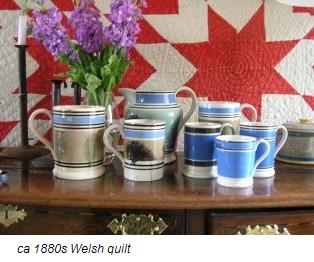
At first I was rather intimidated by the quilts and quite daunted at the
prospect of making one in their style. They were so intensively stitched, their
patterning so intricate and the designs seemed so complex that I didnŌĆÖt think
that I would ever be able to do such highly skilled and time consuming work.
However, when I began recording their formats and the motifs that were regularly
used I came to understand how they were planned and worked.
The most encouraging thing I discovered was that their quilts, though
wonderfully stitched, were not perfect because the women (it was mostly women
who worked the quilts that survive today) made them to commission and worked
quickly. If they made a mistake in the patterning they didnŌĆÖt unpick but simply
carried on, cleverly manipulating motifs and using dense stitching to disguise
any inconsistencies. Not only did this approach appeal to me as a beginner but
it made the quilts much more interesting. though
wonderfully stitched, were not perfect because the women (it was mostly women
who worked the quilts that survive today) made them to commission and worked
quickly. If they made a mistake in the patterning they didnŌĆÖt unpick but simply
carried on, cleverly manipulating motifs and using dense stitching to disguise
any inconsistencies. Not only did this approach appeal to me as a beginner but
it made the quilts much more interesting.
I decided that I wanted to adapt the old ways to suit me and my existing
equipment. I felt that by doing this I really wou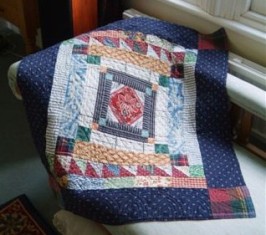 ld be carrying on the tradition
of 19th century country quilters, which was the group that I most admired. These
were poor but practical women who used everyday objects such as cups, saucers
and plates to form their designs. Their craft drew from their environment and
they adapted their way of working to suit the way they lived their lives in the
country areas of South and West Wales in the last half of the 19th century. ld be carrying on the tradition
of 19th century country quilters, which was the group that I most admired. These
were poor but practical women who used everyday objects such as cups, saucers
and plates to form their designs. Their craft drew from their environment and
they adapted their way of working to suit the way they lived their lives in the
country areas of South and West Wales in the last half of the 19th century.
One could say that each quilt told its own tale and the personality of its
quilter shone through the intervening decades. I found them totally inspiring
and it eventually led me to co-authoring the book
MAKING WELSH QUILTS which now
gives anyone interested all the information that I had been looking for myself
when I began.
 Making the patchwork with a mixture of hand and machine piecing
can be done relatively quickly, though selecting the right fabrics can take
time, but, as it is so important to get the look I want, I donŌĆÖt mind how long
it takes. I feel that I have served a 30-year apprenticeship making many types
of quilts, but now, finally, I am making the quilts that have always been my
quilting ŌĆśdestinyŌĆÖ. Making the patchwork with a mixture of hand and machine piecing
can be done relatively quickly, though selecting the right fabrics can take
time, but, as it is so important to get the look I want, I donŌĆÖt mind how long
it takes. I feel that I have served a 30-year apprenticeship making many types
of quilts, but now, finally, I am making the quilts that have always been my
quilting ŌĆśdestinyŌĆÖ.
In the 21st century things are very different. We still have the sheep in Wales,
but there are just a few woolen mills left producing fabric mostly aimed at the
tourist market. Now we are making quilts as a hobby, not a job as it was years
ago. Because we use imported fabrics (or perhaps paint and dye our own fabric)
and use many new techniques, no one could say where our quilts were made and in
no way could they be identified as Welsh!
Should we worry about this? Yes I think we should. Of course we should try new
things and experiment just like everybody else, but we have such a rich and
unique quilting heritage here in Wales, it would be a shame if it was lost and
nobody practiced it in its home country. But what is to be done? Welsh quilting
takes time and everyone seems in such a hurry. They enjoy making patchwork but
few do hand work. Most people piece and quilt on their sewing machine or have it
quilted by a long armed machine quilter.
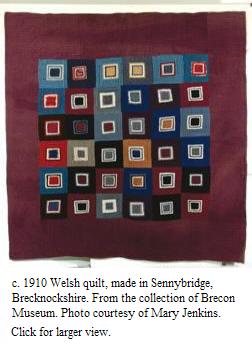
There is no doubt that Welsh quilts are respected greatly by the textile world
and now much more so in Wales itself. Gone are the days when quilts were
mistreated and ended up covering cars in winter and being used as beds for
animals. They are now a diminishing resource and worth money and that fact alone
commands respect. However, we still donŌĆÖt have enough people quilting in the
Welsh style here, nor is the craft being supported with grants or recorded for
posterity as are many other endangered aspects of Welsh life. So it seems it is
down to the quilters themselves to carry on the tradition. It is entirely in our
hands and a few of us are busy fanning the extinguishing flames. However, one
interesting fact has just come to light; the Prince of Wales and the Duchess of
Cornwall have a collection of Welsh quilts in their newly renovated Welsh
farmhouse and the Prince is reported to have said that he likes quilts
especially Welsh ones! Welsh quilts canŌĆÖt get more high profile than that!
Mary now lives in the capital of Wales, Cardiff and runs the website
www.welshquilts.co.uk.
She makes as many Welsh quilts as time will allow and exhibits them regularly.
She advises the Museum of Welsh Life on their quilt collection and curated the
first comprehensive exhibition of Welsh Samplers for Brecon Museum. She is also
a member of the EmbroiderersŌĆÖ Guild and a contributor to their book MAKING
SAMPLERS and designed one of their first needlework kits.
For more about the authors, Mary and Clare:
http://www.welshquilts.co.uk/index.html |